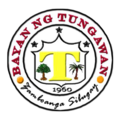Tungawan | |
|---|---|
| Municipality of Tungawan | |
 Map of Zamboanga Sibugay with Tungawan highlighted | |
Location within the Philippines | |
| Coordinates: 7°36′17″N122°25′22″E / 7.6047°N 122.4228°E | |
| Country | Philippines |
| Region | Zamboanga Peninsula |
| Province | Zamboanga Sibugay |
| District | 2nd district |
| Founded | May 24, 1960 |
| Barangays | 25 (see Barangays) |
| Government | |
| • Type | Sangguniang Bayan |
| • Mayor | Carlnan C. Climaco |
| • Vice Mayor | Ivan N. Balano |
| • Representative | Dr. Marly T. Hofer-Hasim |
| • Municipal Council | Members |
| • Electorate | 34,367 voters (2025) |
| Area | |
• Total | 473.28 km2 (182.73 sq mi) |
| Highest elevation | 180 m (590 ft) |
| Lowest elevation | −2 m (−7 ft) |
| Population (2024 census) [3] | |
• Total | 48,013 |
| • Density | 100/km2 (260/sq mi) |
| • Households | 10,523 |
| Economy | |
| • Income class | 2nd municipal income class |
| • Poverty incidence | 36.99 |
| • Revenue | ₱ 310.8 million (2022) |
| • Assets | ₱ 543.9 million (2022) |
| • Expenditure | ₱ 277.8 million (2022) |
| • Liabilities | ₱ 187.7 million (2022) |
| Service provider | |
| • Electricity | Zamboanga del Sur 2 Electric Cooperative (ZAMSURECO 2) |
| Time zone | UTC+8 (PST) |
| ZIP code | 7018 |
| PSGC | |
| IDD : area code | +63 (0)62 |
| Native languages | Subanon Cebuano Chavacano Tagalog |
| Website | www |
Tungawan, officially the Municipality of Tungawan (Cebuano : Lungsod sa Tungawan; Chavacano: Municipalidad de Tungawan; Tagalog : Bayan ng Tungawan), is a municipality in the province of Zamboanga Sibugay, Philippines. According to the 2020 census, it has a population of 46,497 people. [5]
Contents
It has an area of 47,328 hectares (116,950 acres) of land, the largest in the province, as well as 15,236 hectares (37,650 acres) of coastal waters.
It was declared as a municipality on May 24, 1959, and started functioning as a Local Government Unit (LGU) on January 29, 1961, by virtue of Executive Order No. 395. [6] Its name was coined from the minute leech generally known as “tungaw” of the Hirudo family.
Tungawan's economy is primarily based on agriculture, producing rubber, coconut, corn, rice, and seaweeds. It is home to the 880 hectares Bangaan Marine Sanctuary at Barangays Linguisan and Tigbucay.



